Questions from the blog, using up a bumper harvest...
Mimi asked a couple of great questions on the last blog & as they relate to all who have veggie gardens I thought it was worthy of a longer response..
Mimi asked,
"Rob, maybe you can help me get my head around this. It seems to be a problem for many of we novice gardeners. How do you know to estimate the quantity of each thing you plant? The biggest issues I face are either insufficient yield or over supply.
Is it just common sense over a long period of experience, or do you just deal with these issues as part and parcel of the exercise?"
The short answer on the blog I gave was,
"How many of each plant just comes with experience I think.. We have only been gardening for 4 or so years so we are still learning as we grow go ;)».. I have learned that variety is better than volume.. While we are nowhere near to being self sufficient in veggie production we are very lucky that we can make many different types of meals form the varieties of veggies we grow.. "
The long answer I thought was worth sharing as I know it can be rather daunting when the kitchen bench is covered in 1 type of veggie & all inspiration has flown the coup.. It has gotten to the point where Bianca & the kids cringe when they ask what's for dinner, knowing it will involve yet another helping of zucchini, eggplant, chard or a combination of all three for the 5th or 6th meal in a row.. The challenge for me over the past few years is trying to find new ways to prepare the food & keep everyone happy with the meals that are cooked..
As an example, for our family of 4 we will plant 3-4 zucchini realising that there will be an excess if the yield is good.. I can usually serve 3 or 4 meals a week using them in different ways without the boredom that sets in.. Zucchini makes a great raw pasta that you can top with traditional sauces, which is also great if you are watching your carbohydrate intake.. We are lucky enough to have a spiralizer that will cut zucchini & other veggies into spaghetti like threads but the same can be achieved with a potato peeler or mandolin to make thin fettuccini style strips.. When grated it can be used in baked vegetable slice, added to rissoles & goes great in a raw broccoli salad..
Variety can also come into play, rather than volume, when it comes to growing a productive garden.. One example of this is the types of greens we have started to grow like Egyptian spinach, orach & kang kong..
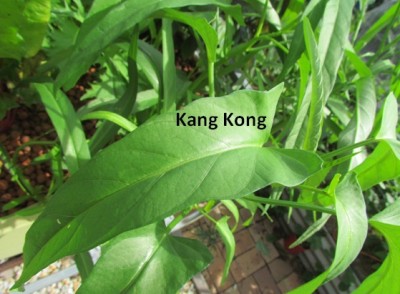 While I have only planted out a few plants of each there are more than enough to give us a constant diverse range of greens for our salads..
While I have only planted out a few plants of each there are more than enough to give us a constant diverse range of greens for our salads..
We are never really concerned with excess greens as the worms, fish & chooks will always look after any excess & they always appreciate it..
As I learn more about gardening, I have started to progressively sow out certain crops, like beetroot & carrot, every 4 weeks or so.. I have also started to do this with our winter broccoli & cauliflower crops.. This way we will (in theory) end up with a constant supply of these crops without any excess occurring.. It also saves storage space in fridges, freezers & pantries as the veggies are stored fresh in the garden : )»
Swapping with others is a great way to make use of excess veggies as well.. Other gardeners may have better yields with other crops & be very grateful for some diversity in their diet as well.. Much of our excess produce has been given away to very grateful family & friends.. The upside to this is that it has inspired a few of them to start planning & planting out their own veggie patches.. We are looking forward to swapping with them in the near future :D»
Storing excess produce..
Freezing, drying & bottling (canning) are the best way to make a bumper harvest stretch out longer..
A favourite way to use up excess here is a veggie sauce made with zucchini, tomatoes, eggplant, onions, mushrooms & garlic.. It can then be frozen or canned for later use.. Once thawed it is as easy as adding the desired spice/herb blend when re heating & letting it simmer for a while to let the flavours infuse through the sauce.. I like to leave it chunky when I freeze it, then if the recipe calls for it, I can process it into a thin sauce.. We use it in Mexican, Italian, Middle Eastern or any dish that calls for a vegetable sauce..
Drying is also a great way to save produce for later use..
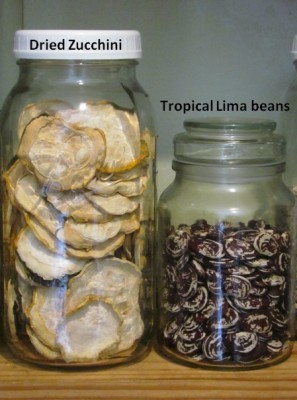 We have recently purchased a dehydrator & have used it to preserve some of our large zucchini for later use in stews & curries.. I think it will get a great workout once the tomatoes are ready to come off..
We have recently purchased a dehydrator & have used it to preserve some of our large zucchini for later use in stews & curries.. I think it will get a great workout once the tomatoes are ready to come off..
Bottling is a skill that I am only just starting to explore a lot more recently..
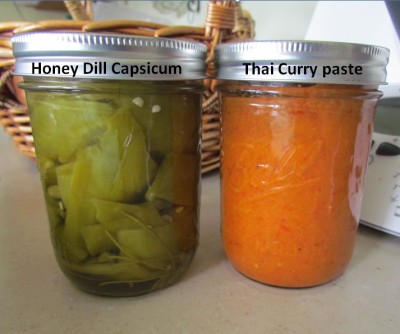 We have been making up a LOT of Thai style curry & chilli pastes from all the chillies we have been lucky enough to harvest this season.. Most of the jars are being given away as we already have a year's worth in the pantry from earlier batches.. We were also forced to harvest some capsicums early on in the summer due to fly strike.. Once any hitch hikers were removed they were quickly processed with some vinegar, honey & dill to make some very tasty pickled capsicum that tastes fantastic in fresh salsa..
We have been making up a LOT of Thai style curry & chilli pastes from all the chillies we have been lucky enough to harvest this season.. Most of the jars are being given away as we already have a year's worth in the pantry from earlier batches.. We were also forced to harvest some capsicums early on in the summer due to fly strike.. Once any hitch hikers were removed they were quickly processed with some vinegar, honey & dill to make some very tasty pickled capsicum that tastes fantastic in fresh salsa..
I hope this give a you a few ideas on how to use up any excess that you may get from your patch..
Harvesting castings…
After much procrastination I finely got around to harvesting the castings from the bath tub worm farm last week..
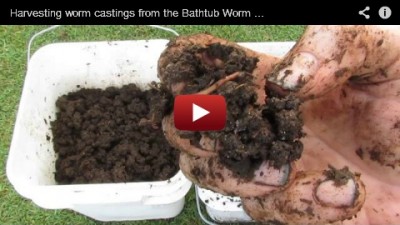 It is a real easy job that only takes a few minutes so not quite sure why I have kept putting it off.. Most of these castings will be used to fertilise the coming seasons seedlings as they are planted out.. I might also make up a few batches of casting "tea" fertiliser if there are any left over ..
It is a real easy job that only takes a few minutes so not quite sure why I have kept putting it off.. Most of these castings will be used to fertilise the coming seasons seedlings as they are planted out.. I might also make up a few batches of casting "tea" fertiliser if there are any left over ..
As shown in the clip, our worm farms are all based on having a well draining bedding (broken up horse manure/coconut fibre) that can be consumed by the worms.. When it comes to feeding the worms kitchen scraps, I like to run them through the food processor & then I add them to the top of the worms bedding.. Water is never added to the farm because the pureed food tends to make the farm moist enough.. In nature you will find compost worms living just under leaf litter where the ground is only slightly damp so I try to mimic that in our farms.. We find this system works great & since adopting this method we haven't had any problems with the farms turning manky like many of our earlier farms used to.. By having the veggie scraps processed, it helps the worms consume it quicker.. This means we will have healthier, faster breeding worms that can in-turn provide us with a nutrient rich fertiliser faster : )»
Our first pineapple…
I posted on the 10th of Feb about having to harvest our first pineapple prematurely as we were concerned about ants & other creepy crawlies trying to eat the soft sun burnt patch on the top side.. Well, I am very happy to report that it ripened up nice & was chopped up yesterday morning for our breakfast..
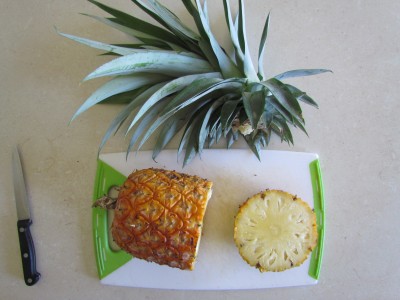 While it was not as sweet as some we have had, it was home grown, so that more than made up for any short comings.. I have been given a few pointers by someone who has a lot more experience than I on how to fertilise this very tasty member of the bromeliad family.. Peter (from the Share the Seed Group on Face Book) recommended lime and potash as great additives to both pineapples & paw paws.. This should help sweeten the fruit, so I shall be adding a small handful to all..
While it was not as sweet as some we have had, it was home grown, so that more than made up for any short comings.. I have been given a few pointers by someone who has a lot more experience than I on how to fertilise this very tasty member of the bromeliad family.. Peter (from the Share the Seed Group on Face Book) recommended lime and potash as great additives to both pineapples & paw paws.. This should help sweeten the fruit, so I shall be adding a small handful to all..
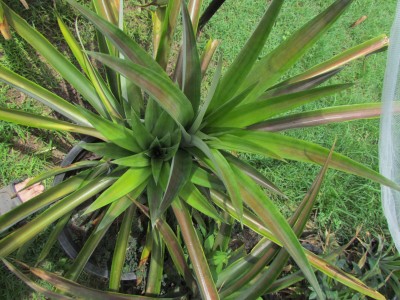 The plant this fruit came from has also produced 2 "pups" which shall be removed from the plant & planted out into pots… Pups are said to fruit a lot faster than plants grown from the crown or seeds so hopefully we might get some fruit from these plants next year..
The plant this fruit came from has also produced 2 "pups" which shall be removed from the plant & planted out into pots… Pups are said to fruit a lot faster than plants grown from the crown or seeds so hopefully we might get some fruit from these plants next year..
That's about it for this week methinks as I have rabbited on quite a lot :D»
Hope you all have a great week in the garden..
: )»

